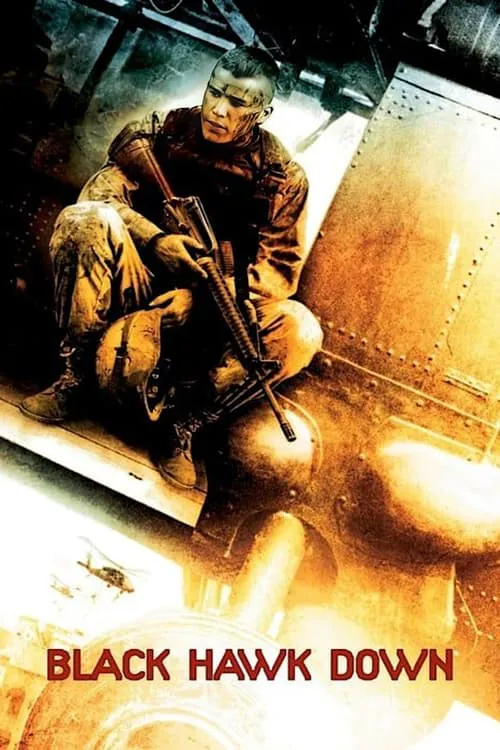Black Hawk Down

Plot
In the midst of the Somali Civil War, a complex web of international politics and humanitarian concerns had led to a United Nations intervention in the war-torn nation. In October 1993, the U.S. government, at the request of the UN, authorized a military operation in Mogadishu with the aim of capturing two top lieutenants of the notorious Somali warlord Mohamed Farrah Aidid: Mohamed Hassan Awale and Omar Salad Elmi. The operation, code-named Mogadishu's "Operation Gothic Serpent," was carefully planned to exploit the deep divisions within Aidid's forces and create an opportunity to apprehend the individuals. A team of U.S. Rangers, under the command of Lieutenant Colonel Daniel McKinnon, was assigned to execute the mission. They were supported by a contingent of elite Delta Force operatives, who would provide the necessary firepower and expertise to facilitate the extraction of the two targets. A squadron of six highly advanced Black Hawk helicopters, piloted by experienced U.S. Army aviators, was flown in from the U.S. military base at Djibouti to transport the assault teams and equipment to the designated drop zone in Mogadishu. The operation began at dawn on October 3, 1993, as the Black Hawks touched down in the heart of the city. The Rangers, led by Staff Sergeant Matt Eversmann, launched a swift and decisive assault on the target compound, taking down several Somali militiamen in the process. The mission got off to a relatively smooth start, but it soon became apparent that the situation was far more fluid and treacherous than anticipated. As the initial forces secured the target area, it became clear that some individuals had managed to slip away. In the chaos that ensued, the U.S. forces moved swiftly to round up the remaining Awale and Elmi loyalists, but a disproportionate response from the Somali militiamen caught the Americans off guard. In a city chocked full of makeshift fighting positions and hardened militia leaders, all things quickly turned grim for the U.S. forces on the ground. Back in the Black Hawk airbase, mission commanders realized that the operation had turned sour, with U.S. casualties mounting at an alarming rate. The high-risk exposure in the narrow city environment offered perfect kill zones for the roving and cunning Somali fighters. Air support assets struggled to navigate the treacherous skies and keep track of the myriad of smoke-spewing and bullet-scarred Black Hawks in flight that strained the pilots and crew. As the situation continued to deteriorate on the ground, those Black Hawks left in the air were shot out of the sky, one by one, within striking distance of gun-wielding militiamen positioned along major routes and alleyways in the crowded city square. The images of U.S. soldiers, clad in bullet-proof attire and gloves, desperately fighting off enemy forces along shattered streets of Mogadishu became a poignant reminder of the brutal reality of the situation unfolding. In an era where satellite communication allowed almost instantaneous feedback, not one American soldier believed they were invincible. Their resilience was tested as bullets riddled the ground under them. Rallied bravely but driven by a harsh situation that cast doubts in many minds, a gallant United States crew relied heavily on resolute small unit battlefield skills and air support to attempt to contain a well-fed chaos driven by hostile fighters against massive support. As time seemed to slow down for those in it, relief at the sight of their hovering Black Hawks, helicopters swarmed in to supply air reinforcement, led by support of the then-CO of an Operations Cell from Djibouti Air Force Command Base deployed overseas to bolster efforts back home. That first support provided hope in the lives of young brave men. Stripped bare into the last desperate hours, it would go a long way in reviving those deeply-troubled fighting spirits that one minute saw them grapple for life amidst an unprecedented unrelenting enemy close-down that put over a hundred U.S. military personnel back into a war that many signed up to prevent from the first day. Urgent battlefield communication worked quickly to contact local aid units on the periphery of combat theater where medical men and women huddled and dazed awaiting expected mass casualties. One rescue after another filled the rescue squad and the combat evacuations off the battleground amidst the chaos offered hope to America as gun fire lingered interminably down the lines to the very end of a desperate daylight clash and evacuation. In the backdrop of the most challenging day for U.S. Forces on foreign soil in roughly nearly three decades, that which unfolded proved an illustration of exceptional valour in the midst of perilous engagement, one of unrelenting strength – each courageous loss, more often heroic valour transcended whatever anguish might mark off U.S. Military losses on a city fought through in an unfamiliar land, where at that time there is no end in sight of U.S. casualties.
Reviews
Miles
The legendary pantheon of Hollywood heartthrobs, AKA how my 'wall of favorites' formed a Great Wall in just one movie.
Eleanor
Ironically, one of Aidid's sons became a U.S. Marine.
Hudson
It's viewed almost like a case study in how a mission fails. While the combat scenes are plentiful, the informational depth feels lacking. The brutal and savage nature of war is self-evident, but the film only humanizes the American soldiers. The frenzied Somali soldiers are merely born into and die in silence, failing to offer a point of connection or understanding. The soundtrack, however, is quite good.
Alan
No sentimental flashbacks of "Saving Private Ryan", nor the agonizing reflections of "Apocalypse Now", only war exists here, a realistic and brutal war!
Cora
This movie is as explosively chaotic as a New Year's Eve celebration!
Recommendations

